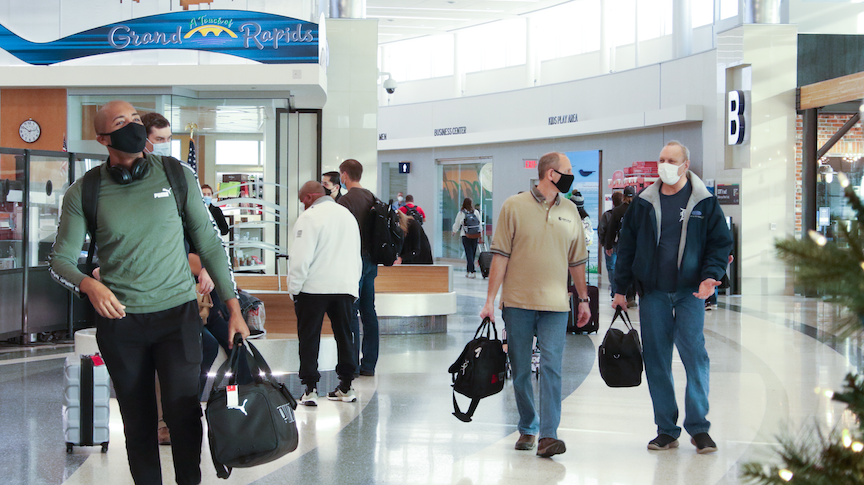Travel and tourism in West Michigan will continue its upward trajectory in 2022 as it rebounds from the pandemic.
Tory Richardson, president and CEO of Gerald Ford International Airport (GFIA), said he is optimistic that by the end of 2022, the airport will reach a point where it will be close to record-breaking growth in terms of travel numbers.
“We had seven consecutive years of growth, record-breaking growth up until 2019,” he said. “That was our best year ever and that was on top of six other consecutive years of the best year ever. It was a pretty healthy trajectory, and we think that we are going to get pretty close to that at the end of next year and into what we consider is going to be growth going forward.”
The Business Journal reported that in 2019, 3,587,767 passengers flew in and out of GFIA. That was an increase of 9.88% from 2018. The steady increase in passenger travel started in 2013 when 2,237,979 passengers traveled in and out of the airport.
In April 2020, the airport saw more than a 96% drop in airport travel. Richardson said he expects to see between 81% and 82% of the pre pandemic number of people traveling through the airport this year.
From January to November 2020, there were 1,615,006 passengers who flew in and out of the airport. During the same period this year, January to November 2021, there were 2,641, 866 passengers traveling in and out of GFIA.
As the number of travelers increases, the type of travelers has changed. Richardson said leisure passenger traffic has increased. He said while the number of business travelers is recovering, it’s not at the level prior to the pandemic.
Richardson said approximately 60% of travelers at the airport were business travelers prior to the pandemic. Now, however, he estimates 80% of travelers are leisure travelers.
Richardson acknowledged his estimation is anecdotal. He said he used to be able to differentiate business and leisure travelers by the way they purchased their tickets, but that, too, has changed.
He based his estimation on what he sees when he is walking through the terminals. He said he sees more people traveling in groups and going to “fun destinations” with friends and family as opposed to people who are traveling alone, carrying a briefcase, and wearing clothing with their company’s name.
“We are still missing a portion of our traffic mix,” he said. “I think some of those people opted to work remote and by working remote, you can either do that from your home here in West Michigan during the winter or go somewhere where it is sunny and warm and work from the beach or on the patio down south somewhere. So, we saw what would be business travelers convert to a leisure market traveler because they could do that and do their work from those locations, so they kind of converted to a leisure traveler as opposed to a business traveler.
“I don’t think we’ll see the business traffic come back exactly the way it was pre-pandemic, but I do think we’ll see more of a business market mix come back once everyone is back in their offices and working more consistently from an office. It will not be the same. It will not be a 100% of what it was before. I think technology has come a long way and people have found ways to make that technology be a tool that works for them, but there is still business development and creating new relationships that will have to happen with social interaction and networking, meaning people needing to connect in person as opposed to via Zoom.”
The increase in leisure travelers also is notable to Doug Small, president of Experience Grand Rapids, an organization that markets Grand Rapids as a visitor destination.
Experience GR tracks the travel activities of different types of people who visit Grand Rapids, which includes leisure travelers, group travelers and corporate travelers.
Small said March was the first month since the pandemic began that his organization saw hotel occupancy rates in Kent County exceed 2020 pandemic rates.
“We were averaging 80% occupancy over Friday and Saturday nights during the summertime, with the majority of that being leisure business,” he said. “That compared favorably to what 2019 showed us. In fact, we had a couple weekend nights during the summer when we had 90% occupancy throughout the county. There are 10,300 hotel rooms in the county and so to us, the leisure business was back to what it was pre-pandemic.”
While leisure business increases, Small said corporate transient business continues to “hold us down and not get us all the way back.” Although the organization does not track the number of different types of travelers, he said he believes that corporate travel is down approximately 50%.
Small estimates group travelers are about 58% to 60% of what they were pre-pandemic because groups canceled or rescheduled the events they had planned in 2020 and 2021.
“I think leisure will continue to be strong going in next year,” he said. “I think we are going to see groups finally start to come back. By the end of 2022, we are predicting that we still will not be at 2019 numbers, but I think by 2023, we can be back to full. I think the last thing to come back, and may not ever come back fully, is that individual corporate traveler. I think a lot of corporations learned that they could do business online. This is just my own opinion, but I hope and think this will be fairly short-lived. At some point corporations will figure out that face-to-face contact wins business and it will come back. When that will come back, I don’t know, maybe 2025, but corporate transient will be the last segment of our business to come back.”
Unlock the world’s wonders with unforgettable journeys tailored just for you! Whether you crave sun-kissed beaches, thrilling adventures, or rich cultural escapes, your dream destination awaits. Enjoy seamless travel with expert tips, exclusive deals, and handpicked experiences that Turn Every Trip into a lifetime memory.










